倒装句语法及练习.
高中英语语法倒装句讲解及练习(附答案)教学文案
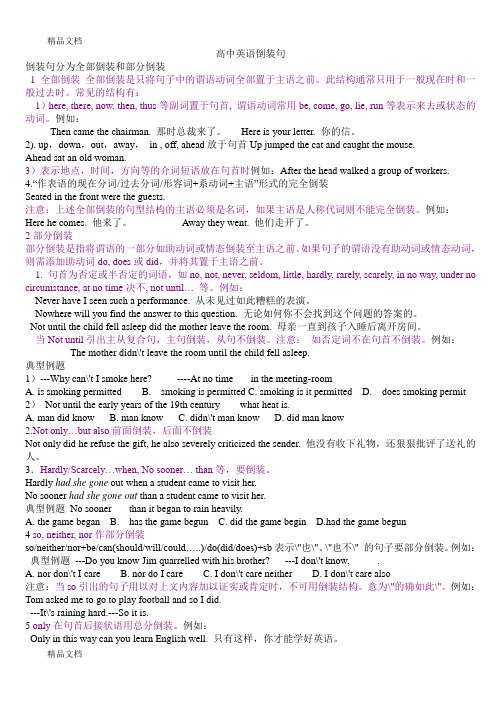
高中英语倒装句倒装句分为全部倒装和部分倒装1全部倒装全部倒装是只将句子中的谓语动词全部置于主语之前。
此结构通常只用于一般现在时和一般过去时。
常见的结构有:1)here, there, now, then, thus等副词置于句首, 谓语动词常用be, come, go, lie, run等表示来去或状态的动词。
例如:Then came the chairman. 那时总裁来了。
Here is your letter. 你的信。
2). up,down,out,away,in , off, ahead放于句首Up jumped the cat and caught the mouse.Ahead sat an old woman.3)表示地点,时间,方向等的介词短语放在句首时例如:After the head walked a group of workers.4.“作表语的现在分词/过去分词/形容词+系动词+主语”形式的完全倒装Seated in the front were the guests.注意:上述全部倒装的句型结构的主语必须是名词,如果主语是人称代词则不能完全倒装。
例如:Here he comes. 他来了。
Away they went. 他们走开了。
2部分倒装部分倒装是指将谓语的一部分如助动词或情态倒装至主语之前。
如果句子的谓语没有助动词或情态动词,则需添加助动词do, does或did,并将其置于主语之前。
1. 句首为否定或半否定的词语,如no, not, never, seldom, little, hardly, rarely, scarely, in no way, under no circumstance, at no time决不, not until… 等。
例如:Never have I seen such a performance. 从未见过如此糟糕的表演。
Nowhere will you find the answer to this question. 无论如何你不会找到这个问题的答案的。
倒 装 句(含讲解和题目)
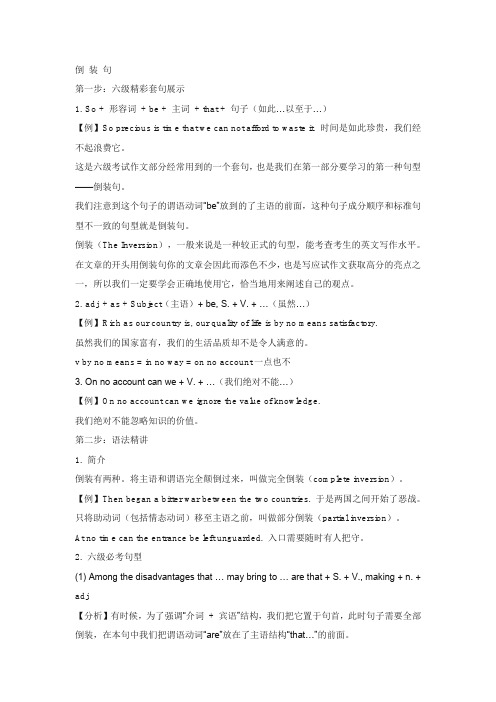
倒装句第一步:六级精彩套句展示1. So + 形容词+ be + 主词+ that + 句子(如此…以至于…)【例】So precious is time that we can not afford to waste it. 时间是如此珍贵,我们经不起浪费它。
这是六级考试作文部分经常用到的一个套句,也是我们在第一部分要学习的第一种句型——倒装句。
我们注意到这个句子的谓语动词“be”放到的了主语的前面,这种句子成分顺序和标准句型不一致的句型就是倒装句。
倒装(The Inversion),一般来说是一种较正式的句型,能考查考生的英文写作水平。
在文章的开头用倒装句你的文章会因此而添色不少,也是写应试作文获取高分的亮点之一,所以我们一定要学会正确地使用它,恰当地用来阐述自己的观点。
2. adj. + as + Subject(主语)+ be, S. + V. + …(虽然…)【例】Rich as our country is, our quality of life is by no means satisfactory.虽然我们的国家富有,我们的生活品质却不是令人满意的。
v by no means = in no way = on no account一点也不3. On no account can we + V. + …(我们绝对不能…)【例】On no account can we ignore the value of knowledge.我们绝对不能忽略知识的价值。
第二步:语法精讲1. 简介倒装有两种。
将主语和谓语完全颠倒过来,叫做完全倒装(complete inversion)。
【例】Then began a bitter war between the two countries. 于是两国之间开始了恶战。
只将助动词(包括情态动词)移至主语之前,叫做部分倒装(partial inversion)。
【英语语法】倒装句专项练习(含答案解析)
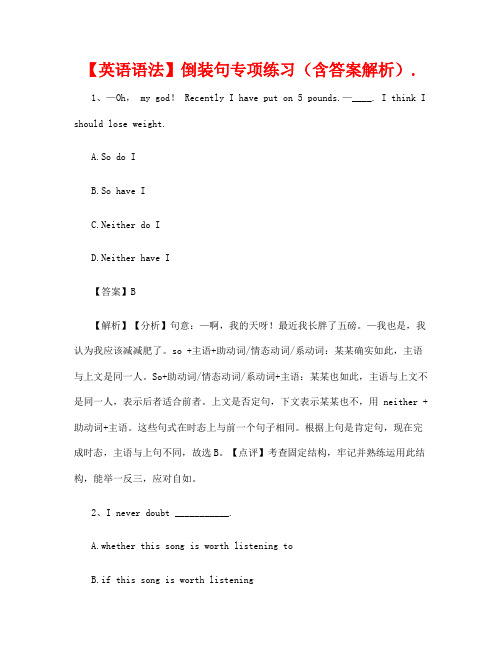
【英语语法】倒装句专项练习(含答案解析).1、—Oh, my god! Recently I have put on 5 pounds.—____. I think I should lose weight.A.So do IB.So have IC.Neither do ID.Neither have I【答案】B【解析】【分析】句意:—啊,我的天呀!最近我长胖了五磅。
—我也是,我认为我应该减减肥了。
so +主语+助动词/情态动词/系动词:某某确实如此,主语与上文是同一人。
So+助动词/情态动词/系动词+主语:某某也如此,主语与上文不是同一人,表示后者适合前者。
上文是否定句,下文表示某某也不,用 neither +助动词+主语。
这些句式在时态上与前一个句子相同。
根据上句是肯定句,现在完成时态,主语与上句不同,故选B。
【点评】考查固定结构,牢记并熟练运用此结构,能举一反三,应对自如。
2、I never doubt ___________.A.whether this song is worth listening toB.if this song is worth listeningC.that this song is worth listeningD.that this song is worth listening to【答案】D【解析】【分析】句意:我从来没有怀疑这首歌值得去听。
根据句子结构分析,本句是宾语从句,根据主句I never doubt,可知从句是陈述句,故排除A 和B,又因为listen to为固定搭配,故选D。
【点评】考查宾语从句。
注意识记宾语从句的用法。
3、— I have changed my job.— ___________A.So do I.B.So have I.C.So I do.D.So I have.【答案】B【解析】【分析】句意: —我换了工作。
—我也是。
(完整版)高中英语语法倒装句讲解及练习(附答案)
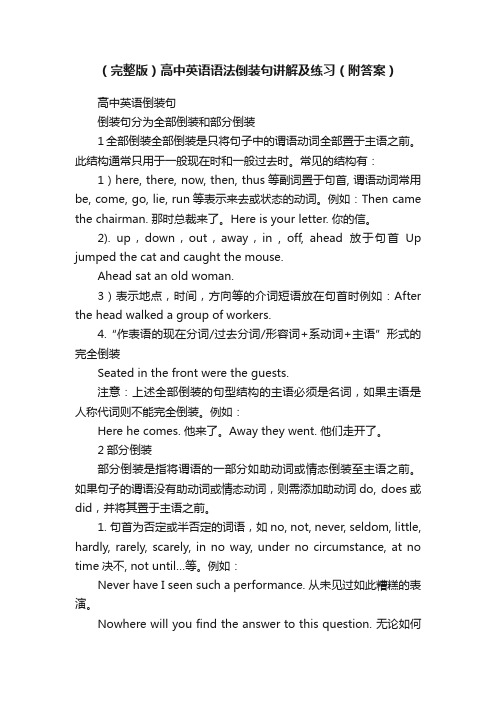
(完整版)高中英语语法倒装句讲解及练习(附答案)高中英语倒装句倒装句分为全部倒装和部分倒装1全部倒装全部倒装是只将句子中的谓语动词全部置于主语之前。
此结构通常只用于一般现在时和一般过去时。
常见的结构有:1)here, there, now, then, thus等副词置于句首, 谓语动词常用be, come, go, lie, run等表示来去或状态的动词。
例如:Then came the chairman. 那时总裁来了。
Here is your letter. 你的信。
2). up,down,out,away,in , off, ahead放于句首Up jumped the cat and caught the mouse.Ahead sat an old woman.3)表示地点,时间,方向等的介词短语放在句首时例如:After the head walked a group of workers.4.“作表语的现在分词/过去分词/形容词+系动词+主语”形式的完全倒装Seated in the front were the guests.注意:上述全部倒装的句型结构的主语必须是名词,如果主语是人称代词则不能完全倒装。
例如:Here he comes. 他来了。
Away they went. 他们走开了。
2部分倒装部分倒装是指将谓语的一部分如助动词或情态倒装至主语之前。
如果句子的谓语没有助动词或情态动词,则需添加助动词do, does或did,并将其置于主语之前。
1. 句首为否定或半否定的词语,如no, not, never, seldom, little, hardly, rarely, scarely, in no way, under no circumstance, at no time决不, not until…等。
例如:Never have I seen such a performance. 从未见过如此糟糕的表演。
英语倒装句讲解与练习
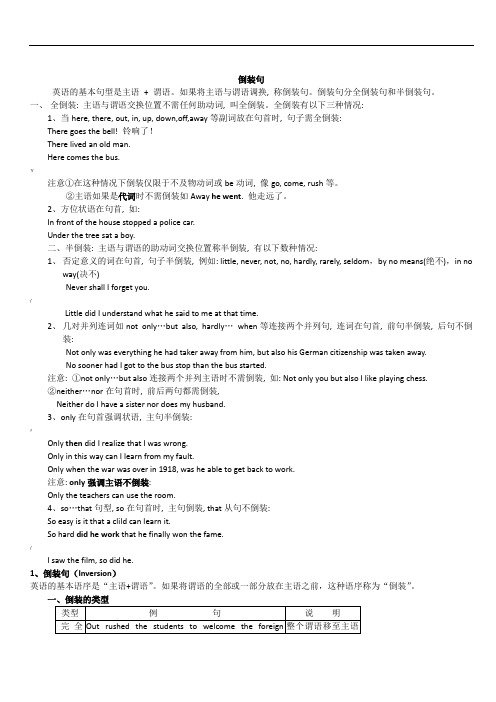
倒装句英语的基本句型是主语+ 谓语。
如果将主语与谓语调换, 称倒装句。
倒装句分全倒装句和半倒装句。
一、全倒装: 主语与谓语交换位置不需任何助动词, 叫全倒装。
全倒装有以下三种情况:1、当here, there, out, in, up, down,off,away等副词放在句首时, 句子需全倒装:There goes the bell! 铃响了!There lived an old man.Here comes the bus.¥注意①在这种情况下倒装仅限于不及物动词或be动词, 像go, come, rush等。
②主语如果是代词时不需倒装如Away he went. 他走远了。
2、方位状语在句首, 如:In front of the house stopped a police car.Under the tree sat a boy.二、半倒装: 主语与谓语的助动词交换位置称半倒装, 有以下数种情况:1、否定意义的词在句首, 句子半倒装, 例如: little, never, not, no, hardly, rarely, seldom,by no means(绝不),in noway(决不)Never shall I forget you./Little did I understand what he said to me at that time.2、几对并列连词如not only…but also, hardly…when等连接两个并列句, 连词在句首, 前句半倒装, 后句不倒装:Not only was everything he had taker away from him, but also his German citizenship was taken away.No sooner had I got to the bus stop than the bus started.注意: ①not only…but also连接两个并列主语时不需倒装, 如: Not only you but also I like playing chess.②neither…nor在句首时, 前后两句都需倒装,Neither do I have a sister nor does my husband.3、only在句首强调状语, 主句半倒装:?Only then did I realize that I was wrong.Only in this way can I learn from my fault.Only when the war was over in 1918, was he able to get back to work.注意: only强调主语不倒装:Only the teachers can use the room.4、so…that句型, so在句首时, 主句倒装, that从句不倒装:So easy is it that a clild can learn it.So hard did he work that he finally won the fame./I saw the film, so did he.1、倒装句(Inversion)英语的基本语序是“主语+谓语”。
[全]英语语法专项“倒装句”考点归纳+试题解析
![[全]英语语法专项“倒装句”考点归纳+试题解析](https://img.taocdn.com/s3/m/ffd6301c9b89680202d8254f.png)
英语语法专项“倒装句”考点归纳+试题解析一、完全倒装完全倒装:将句子中的谓语动词全部置于主语之前。
适合时态:通常只用于一般现在时和一般过去式。
1、here, there, now, then, thus等副词置于句首,谓语动词常用be, come, go, lie, run等表示来去或状态的动词。
e.g. Here is your letter. 这是你的信。
Then came his mother. 那时他妈妈来了。
2、表示运动方向的副词或地点状语置于句首,谓语表示运动的动词。
e.g.Ahead sat an old woman. 前面坐着一个老奶奶。
3、完全倒装句型结构的主语必须是名词。
如果主语是人称代词,不能完全倒装。
e.g.Here he comes. 他来了。
Away they went. 他们走了。
二、部分倒装部分倒装:将谓语的一部分(如助动词、情态动词)倒装至柱与之前。
如果句子的谓语没有助动词或情态动词,则需要添加助动词do, does或did,并将其置于主语之前。
1. 句首为否定或半否定的词语时使用,如no, not, never, seldom, little, hardly, ao no time, in no way, not until 等。
e.g.Nowhere will you find the answer to this question. 你怎么也不可能找到这个问题的答案的。
Never have I seen such a performance. 我从没见过这么糟糕的表演。
2. 用not until 引出主从复合句时,主句倒装,从句不倒装。
e.g.中文:直到孩子入睡后母亲才离开房间。
原句:The mother didn't leave the room until the child fell asleep.倒装句:Not until the child fell asleep didthe mother leave the room.3. 用so, neither, nor表示“也(不)”时,使用部分倒装。
高中英语语法倒装句讲解与练习含答案

高中英语语法倒装句讲解与练习含答案全部倒装1.here,there,out ,in,up,down,now,then,away,over,off等副词位于句首时,后面句子用全部倒装。
(1)There goes the bell.(2)Here comes the bus. (3)Now comes my turn.(4)Then followed three day of rain.注意:主语是代词时,不用此倒装结构(5)Out rushed the children.=The children rushed out.(Out they rushed主语为代词时句子不倒装).(6)In came the teacher and the lesson began.=The teacher came in and the lesson began.In he came and the lesson began.主语为代词时句子不倒装2.表语和地点状语位于句首表示强调意义时,后面用全部倒装,当表示时间的副词或介词词组位于句首时,常常引起全部倒装,注意:主谓一致。
(1)In the distance was a small boat=A small boat was in the distance.(2)Under a big tree sat an old man smoking a pipe.=An old man smoking a pipe sat under a big tree.(3)They arrived at a farm house ,in front of which sat a small boy.(4)On either side were rows of fruit trees.(5)Early in the morning came the news .3.在一些表示祝愿的句子中Long live China.部分倒装1.only修饰句子的状语位于句首时,后面引起部分倒装。
复习语法倒装句练习题及

复习语法倒装句练习题及解答复习语法倒装句练习题及解析1. 完全倒装句练习题a) Never have I seen such a beautiful sunset.b) Little did she know about his true intentions.c) Not only did he play the piano, but he also sang.d) Only when the sun sets do I feel at peace.e) Rarely does she complain about anything.这些句子中,主语和谓语动词的顺序颠倒,是完全倒装句的形式。
这种句式多用于强调句子开头的部分内容,或者是句子开头有否定词、副词、状语等情况。
2. 词序倒装句练习题a) Hardly had he finished his breakfast when the phone rang.b) Seldom have I heard such beautiful music.c) Scarcely had she left the house when it started raining.d) No sooner did he arrive at the airport than the flight was cancelled.e) Under no circumstances should you give up.这些句子中,助动词、情态动词或者是be动词放在主语之前,构成了词序倒装句。
这种句式常用于表示某一情况之后立即出现的另一情况。
3. 条件句中的倒装句练习题a) Had you studied harder, you would have passed the exam.b) Should you have any questions, feel free to ask.c) Were I in your shoes, I would make the same decision.d) Were it not for your help, we would have failed.e) Should it rain tomorrow, we will cancel the outdoor event.这些句子中,条件从句的谓语动词放在主语之前,构成了条件句中的倒装。
中考英语语法之倒装句用法详解及练习分析
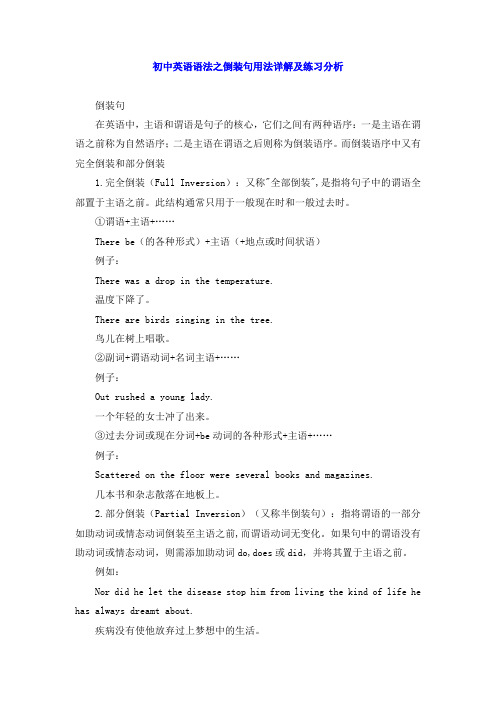
初中英语语法之倒装句用法详解及练习分析倒装句在英语中,主语和谓语是句子的核心,它们之间有两种语序:一是主语在谓语之前称为自然语序;二是主语在谓语之后则称为倒装语序。
而倒装语序中又有完全倒装和部分倒装1.完全倒装(Full Inversion):又称"全部倒装",是指将句子中的谓语全部置于主语之前。
此结构通常只用于一般现在时和一般过去时。
①谓语+主语+……There be(的各种形式)+主语(+地点或时间状语)例子:There was a drop in the temperature.温度下降了。
There are birds singing in the tree.鸟儿在树上唱歌。
②副词+谓语动词+名词主语+……例子:Out rushed a young lady.一个年轻的女士冲了出来。
③过去分词或现在分词+be动词的各种形式+主语+……例子:Scattered on the floor were several books and magazines.几本书和杂志散落在地板上。
2.部分倒装(Partial Inversion)(又称半倒装句):指将谓语的一部分如助动词或情态动词倒装至主语之前,而谓语动词无变化。
如果句中的谓语没有助动词或情态动词,则需添加助动词do,does或did,并将其置于主语之前。
例如:Nor did he let the disease stop him from living the kind of life he has always dreamt about.疾病没有使他放弃过上梦想中的生活。
部分倒装也有以下几种常见类型:1. 以否定词开头的句子要求部分倒装。
注意下列句子中助动词或情态动词提前、甚至补充助动词的用法:例:Not until yesterday did little John change his mind.小约翰直到昨天才改变了主意。
倒装句全面讲解和练习(答案)
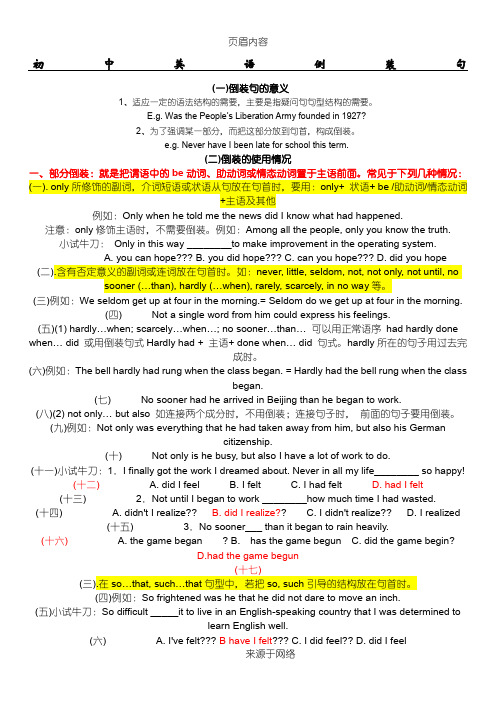
初中英语倒装句(一)倒装句的意义1、适应一定的语法结构的需要,主要是指疑问句句型结构的需要。
E.g. Was the People’s Liberation Army founded in 1927?2、为了强调某一部分,而把这部分放到句首,构成倒装。
e.g. Never have I been late for school this term.(二)倒装的使用情况一、部分倒装:就是把谓语中的be动词、助动词或情态动词置于主语前面。
常见于下列几种情况:(一). only所修饰的副词,介词短语或状语从句放在句首时,要用:only+ 状语+ be /助动词/情态动词+主语及其他例如:Only when he told me the news did I know what had happened.注意:only修饰主语时,不需要倒装。
例如:Among all the people, only you know the truth.小试牛刀:Only in this way ________to make improvement in the operating system.A. you can hope???B. you did hope???C. can you hope???D. did you hope(二).含有否定意义的副词或连词放在句首时。
如:never, little, seldom, not, not only, not until, nosooner (…than), hardly (…when), rarely, scarcely, in no wa y等。
(三)例如:We seldom get up at four in the morning.= Seldom do we get up at four in the morning.(四) Not a single word from him could express his feelings.(五)(1) hardly…when; scarcely…when…; no sooner…than… 可以用正常语序had hardly done when… did 或用倒装句式Hardly had + 主语+ done when… did 句式。
高中英语倒装句讲解以及习题

倒装句一、定义:英语最基本的语序是主语在前,谓语动词在后;但有时由于句子结构的需要或表示强调,就要采用倒装形式;Eg:Thebuscomeshere.Herecomesthebus.车来了;二、分类:全倒装:将谓语动词完全移到主语之前称为完全倒装,半倒装:只将助动词或情态动词放到主语之前称为部分倒装;Eg:Manyyearsagotherelivedanoldmaninthewoodenhouse.很多年前有一位老人住在那间木屋里;NeverhaveIbeenlateforschoolthisterm.这学期,我从来没上学迟到过;三、全倒装:“五全”=有时表地方经常与be/come/exist/fall/follow/go/remain/seem/stand表示移动或动态的不及物动词连用或用表示类似“存在”观念的其他不及物动词如:live,stand,come,lie,flow,enter,rise和appear 等㈠、“有”:在“therebe”结构里Eg:Thereisaboxonthetable.桌子上面有一个盒子;㈡、“时”:表示时间副词,如:now,then,Eg:Nowcomesyourturn.现在轮到你了;㈢、“表”:表语放句子前,“表语+系动词+主语”的结构Eg:.格林先生和其他的客人在这个聚会上;Seatedonthegroundareagroupofyoungmen.一群年轻人坐在了地上;㈣、“地”:地点状语放在句首Eg:Insouthoftheriverliesasmallfactory.小工厂位于河的南方;Fromthevalleycameacry.山谷传来一阵哭声;㈤、“方”:表方位的副词here,there或out,in,up,down,away,off等标志词放在句首Eg:Thereliesalargewheatfieldinfrontofthehouse.房子前面有一大片麦田;OffallthelightswentwhenIcamein.当我进来时,所有的灯都灭了;四、半倒装:“八部”=不只让步也常需虚如此祝福㈠、“不”表示否定①、no,not,never,hardly,no,not,never,hardly,barely,seldom,rarely,scarcely,nolonger,nowhereEg:NeverhaveIbeentoBeijing.我从没有没有去过北京;②、绝不:atntime,innoway,bynomeans,onnoaccount,innocase,in/undernocircumstanceEg:Atnotimecanwegiveup.我们决不能放弃;③、Notuntil...:直到Eg:NotuntilmymothercamehomedidIgotobed.知道我妈妈回家我才睡觉;④、Hardly/Scarcely...过完...when...一过...:一...就...Nosooner...过完...than...一过...:一...就...Eg:Hehadhardlygothomewhenithappenedtorain.=Hadhehardlygothomewhenithappenedtorain.他一到家碰巧就下雨了;⑤、Notonly......butalso......:前倒后不倒Eg:Notonlydidherefusethegift,healsoseverelycriticizedthesender.他没有收下礼物,还狠狠批评了送礼的人㈡、“只”:only所修饰的副词、介词短语或状语从句放在句子开头时;Eg:OnlythendidIrealizethatIwaswrong.只有到那时我才意识到我错了;Onlyinthiswaycanyoulearnfromyourmistake.只有用这样的方法你可以从错误中学习;Onlywhenthewarwasoverin1918washeabletogethappilybacktowork.只有当战争于1918年结束时候,他才能够快乐地回到工作当中;※当only之后所接的不是状语时不可以用倒装Eg:OnlyComradeZhangknowsaboutthematter..只有张同志知道这件事;㈢、“让步”:as/though/although引导让步状语从句时要倒装形/副/名/动+as+主语+谓语Eg:Proudastheyare,theyareafraidtoseeme.尽管他们自豪,但是他们还怕见到我;Childasheis,heseemstoknoweverything.child前不加冠词尽管他是个孩子,但他好像知道一切;Hardasheworded,hemadelittleprogress.尽管他努力工作,但是几乎没什么进步;※以上句中as可以替换though/although,但是as更加常用;㈣、“也”:so/nor/neither开头,表示谓语所述的情况也适用于另一个人或一事物的肯定或否定句so用于肯定句,表示“也一样”“也这样”;nor/neither用于否定句,表示“同样也不,也不这样”; Eg:.我正在看电视,她也在看;Myparentsdidn'NordidI.我父母昨晚没有看电视,我也没有看;※表示两人的同样一个情况时,只能表示一件事,即上、下句所使用的动词、时态要一致;㈤、“常”:表示频度副词如:often、manyatime,nowandagain等经常用于正式的文体中Eg:Oftendidheadvisethemnottosmoke.他经常建议他们不要抽烟;㈥、“需=虚拟”:省略if的虚拟条件句,把助动词were、had、should提到主语前面时Eg:Haditnotbeenforyourhelp,weshouldn'thaveachievedsomuch.要不是你的帮助,我们不可能收获这么多;㈦、“如此”:so/such…that…;从句中,当so+形容词/副词或such+名词位于句首时;Eg:Soexhaustedwasshethatshewantedtohavearest.他是如此地疲惫以至于想要休息一下;㈧、“祝福”:当may放在句首,表达祝愿时;Eg:Mayyousucceed祝你成功五、练习题PartOne单项选择.—Whereismyshirt,mum —_________.—Whereisyourfather —Oh,________.—Ithoughtyouwomenwerepresentatthemeeting.—__________.翻译下列句子;要求:先用正常语序翻译,然后再改写成倒装句;1. 学习做饭不仅使孩子们更加独立,给他们一项基本的生活技能,而且还可以让他们远离垃圾食品;notonly…butalso;independent;junkfood原句:倒装:2. 广告不仅让我们了解最新的产品而且还很有娱乐性;notonly…butalso;keepsbinformedof/aboutsth;product;entertaining原句:倒装:3. 直到最后一刻他才告诉我真相;not…until原句:倒装:4. 直到失去健康你才会意识到它的重要性;not…until原句:倒装:5. 只有用这种方法才能拯救她的生命;only…原句:倒装:6. 只有当他们回来时,我才知道发生了什么事;only原句:倒装:7. 我们有如此多的作业要做以至于我们没有时间放松;so…that;relax原句:倒装:8. Emma是如此的迷人以至于所有人的目光都集中在她身上;so…that;focusone’seyeson原句:倒装:9. 汤姆刚到家电话就响了;hardly…when或者nosooner…than,注意时态原句:倒装:10.他从未想到自己经历十多年的努力后,终于能在激烈的竞争中脱颖而出,并赢得这么多的掌声和鼓励;never原句:倒装:PartThree语法填空Onedayayoungmanwasstandinginthemiddleofthetownproclaiming宣告 1 gather,andtheyalladmiredhisheartforitwasperfect.Suddenly,anoldmanappearedandsaid,“Why,yourheartisnotnearlyasbeautifulas2.”Thecrowdandtheyoungmanlookedattheoldman’sheart, piecesputin,buttheydidn’tfitquiteright,andtherewereseveraljagged凹凸不平的,insomeplacesthereweredeepgouges沟槽wherewholepieceswere 5 miss.Theyoungmanlaughed.“Comparingyourheartwithmine,mineisperfectandyoursisamessofscars.”“Yes,”saidtheoldman,“Yourslooksperfect6,everyscarrepresentsapersonto 7,’texact,Ihavesomeroughedges,whichIcherish,becausetheyremindmeof 8 ,andtheotherpersonhasn’treturnedapieceofhisorherhear t 9 24 remind 10 truebeautyis ”参考答案:单项选择:1—5CABBA6—10BBBDA11—15BCCBA16—20BAACC21—25ABADD26—30BDCDC翻译答案:1.Learningcookingnotonlymakeschildrenmoreindependentandgivesthemabasiclifeskill,butalsokeepsthemaw ayfromjunkfood.倒装:Notonlydoeslearningcookingmakechildrenmoreindependent,….2. Advertisementsnotonlykeepusinformedofthelatestproducts,buttheyalsoareentertaining.倒装:Notonlydoadvertisementskeepusinformedofthelatestproducts,….3. Hedidn’ttellmethetruthuntilthelastmoment.倒装:Notuntilthelastmomentdidhetellmethetruth.4. Youwon’trealizetheimportanceofhealthuntilyouloseit.倒装:Notuntilyouloseitwillyourealizetheimportanceofhealth.5. Wecouldsaveherlifeonlyinthisway.倒装:Onlyinthiswaycouldwesaveherlife.6. Iknewwhathadhappenedonlywhentheyreturnedhome.倒装:OnlywhentheyreturnedhomedidIknowwhathadhappened.7. Wehavesomuchhomeworktodothatwedon’thavetimetorelax.倒装:Somuchhomeworkdowehavetodothatwedon’thavetimetorelax.8. Emmaissoattractivethateveryonefocusestheireyesonher.倒装:SoattractiveisEmmathateveryonefocusestheireyesonher.9. Tomhadhardlygothomewhenthebellrang.倒装:HardlyhadTomgothomewhenthebellrang.Tomhadnosoonergothomethanthebellrang.倒装:NosoonerhadTomgothomethanthebellrang.语法填空:。
倒装句讲解及练习-情态动词+have done 练习
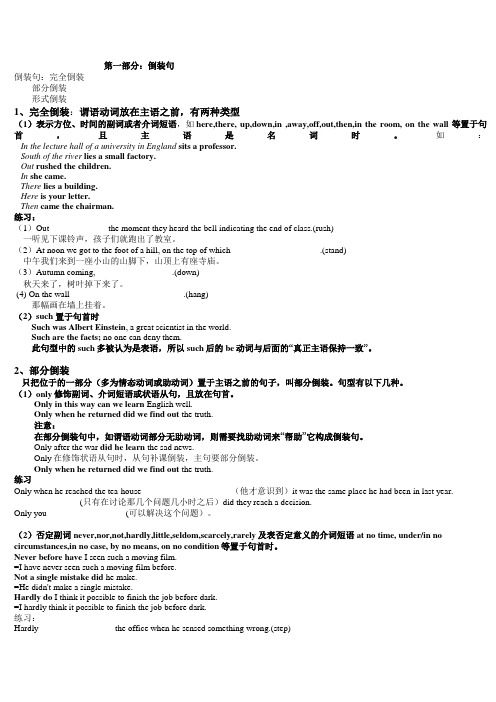
第一部分:倒装句倒装句:完全倒装部分倒装形式倒装1、完全倒装:谓语动词放在主语之前,有两种类型(1)表示方位、时间的副词或者介词短语,如here,there, up,down,in ,away,off,out,then,in the room, on the wall等置于句首,且主语是名词时。
如:In the lecture hall of a university in England sits a professor.South of the river lies a small factory.Out rushed the children.In she came.There lies a building.Here is your letter.Then came the chairman.练习:(1)Out _____________the moment they heard the bell indicating the end of class.(rush)一听见下课铃声,孩子们就跑出了教室。
(2)At noon we got to the foot of a hill, on the top of which ____________________.(stand)中午我们来到一座小山的山脚下,山顶上有座寺庙。
(3)Autumn coming, _________________.(down)秋天来了,树叶掉下来了。
(4) On the wall__________________________.(hang)那幅画在墙上挂着。
(2)such 置于句首时Such was Albert Einstein, a great scientist in the world.Such are the facts; no one can deny them.此句型中的such多被认为是表语,所以such后的be动词与后面的“真正主语保持一致”。
【英语语法】倒装句专项练习(含答案解析)
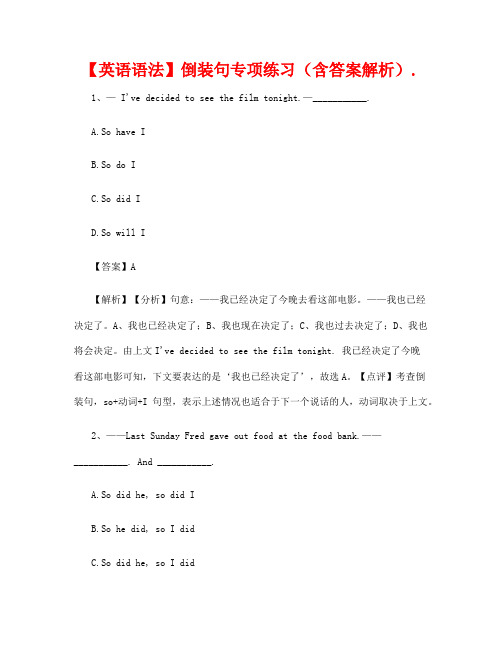
【英语语法】倒装句专项练习(含答案解析).1、— I've decided to see the film tonight.—___________.A.So have IB.So do IC.So did ID.So will I【答案】A【解析】【分析】句意:——我已经决定了今晚去看这部电影。
——我也已经决定了。
A、我也已经决定了;B、我也现在决定了;C、我也过去决定了;D、我也将会决定。
由上文I've decided to see the film tonight. 我已经决定了今晚看这部电影可知,下文要表达的是‘我也已经决定了’,故选A。
【点评】考查倒装句,so+动词+I句型,表示上述情况也适合于下一个说话的人,动词取决于上文。
2、——Last Sunday Fred gave out food at the food bank.——___________. And ___________.A.So did he, so did IB.So he did, so I didC.So did he, so I didD.So he did, so did I【答案】D【解析】【分析】句意:上周日弗莱德在食物银行分发食物。
他确实在,我也在。
“so+助动词(情态动词或连系动词)+另一主语”,此句型是主谓倒装结构,可以表示前面的情况也适用于后者,使用该句型需要注意以几个方面的问题:1.该句型只能用于肯定句,不能用于否定句:如果前句是否定句,则要用“neither /nor +助动词+主语”。
2.句型中的主语与上文中的主语是不同的两个主语3.句型中助动词,包括连系动词和情态动词的时态要和上句中谓语动词的时态相一致。
4. 如果第二分句只是重复前句的意思,用来表示赞同时,so之后的主语和谓语就不能颠倒。
所以选D。
【点评】考查so的用法。
3、— I think the plan is just a waste of time. What do you think?—Well, if you don't support the plan, ___________.A.neither do IB.so do IC.neither will ID.so will I【答案】C【解析】【分析】句意:——我认为这个计划只是在浪费时间。
(完整版)初中语法-专题十四倒装句及练习
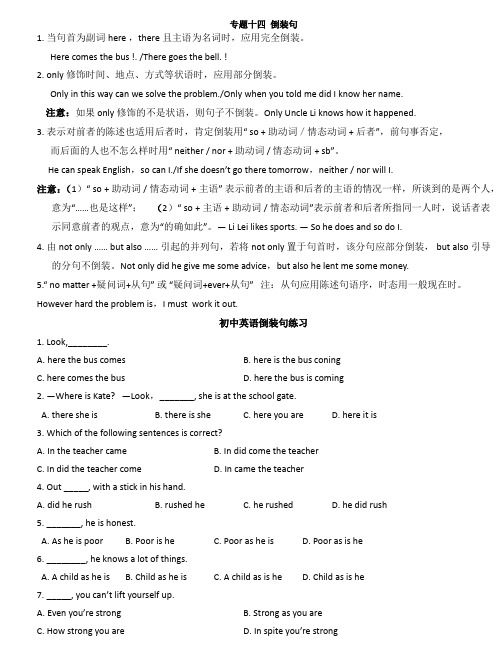
专题十四倒装句1. 当句首为副词here ,there 且主语为名词时,应用完全倒装。
Here comes the bus !. /There goes the bell. !2. only 修饰时间、地点、方式等状语时,应用部分倒装。
Only in this way can we solve the problem./Only when you told me did I know her name.注意:如果 only 修饰的不是状语,则句子不倒装。
Only Uncle Li knows how it happened.3. 表示对前者的陈述也适用后者时,肯定倒装用“ so + 助动词/情态动词 + 后者”,前句事否定,而后面的人也不怎么样时用“ neither / nor + 助动词 / 情态动词 + sb”。
He can speak English,so can I./If she doesn’t go there tomorrow,neither / nor will I.注意:(1)“ so + 助动词 / 情态动词 + 主语” 表示前者的主语和后者的主语的情况一样,所谈到的是两个人,意为“……也是这样”;(2)“ so + 主语 + 助动词 / 情态动词”表示前者和后者所指同一人时,说话者表示同意前者的观点,意为“的确如此”。
— Li Lei likes sports. — So he does and so do I.4. 由 not only …… but also …… 引起的并列句,若将 not only 置于句首时,该分句应部分倒装, but also 引导的分句不倒装。
Not only did he give me some advice,but also he lent me some money.5.“ no matter +疑问词+从句” 或 “疑问词+ever+从句” 注:从句应用陈述句语序,时态用一般现在时。
倒装句子((精选))

12. ____ a mobile phone can you ring ___ you want to talk with anywhere. A. Using; whoever B. Only on; whoever C. With; whoever D. Using; whomever
2. Rewrite these sentence using normal word order.
1) I did not know how to use that recorder. Neither did he. I did not know how to use that recorder and he did not know, either.
no time, not only 等否定词开头的句子 里。 Never shall I do this again. At no time can you say “no” to the order. Little do I dream I would see you here.
Seldom have we felt as comfortable as here. Not only did he hear it, but he saw it as well. At no time was the entrance left unguarded.
8. Little ___ know about verbs, Franz __ his head. A. did he; dare not lift B. he; dare not lift C. did he; dare not to lift D. doesn’t; doesn’t dare lift
英语语法归纳总结及倒装句(附答案)
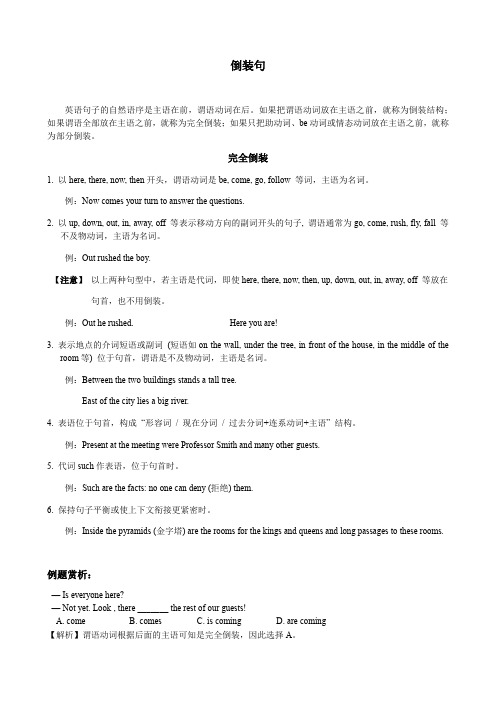
倒装句英语句子的自然语序是主语在前,谓语动词在后。
如果把谓语动词放在主语之前,就称为倒装结构;如果谓语全部放在主语之前,就称为完全倒装;如果只把助动词、be动词或情态动词放在主语之前,就称为部分倒装。
完全倒装1. 以here, there, now, then开头,谓语动词是be, come, go, follow 等词,主语为名词。
例:Now comes your turn to answer the questions.2. 以up, down, out, in, away, off 等表示移动方向的副词开头的句子, 谓语通常为go, come, rush, fly, fall 等不及物动词,主语为名词。
例:Out rushed the boy.【注意】以上两种句型中,若主语是代词,即使here, there, now, then, up, down, out, in, away, off 等放在句首,也不用倒装。
例:Out he rushed. Here you are!3. 表示地点的介词短语或副词(短语如on the wall, under the tree, in front of the house, in the middle of theroom等) 位于句首,谓语是不及物动词,主语是名词。
例:Between the two buildings stands a tall tree.East of the city lies a big river.4. 表语位于句首,构成“形容词/ 现在分词/ 过去分词+连系动词+主语” 结构。
例:Present at the meeting were Professor Smith and many other guests.5. 代词such作表语,位于句首时。
例:Such are the facts: no one can deny (拒绝) them.6. 保持句子平衡或使上下文衔接更紧密时。
语法中的倒装句
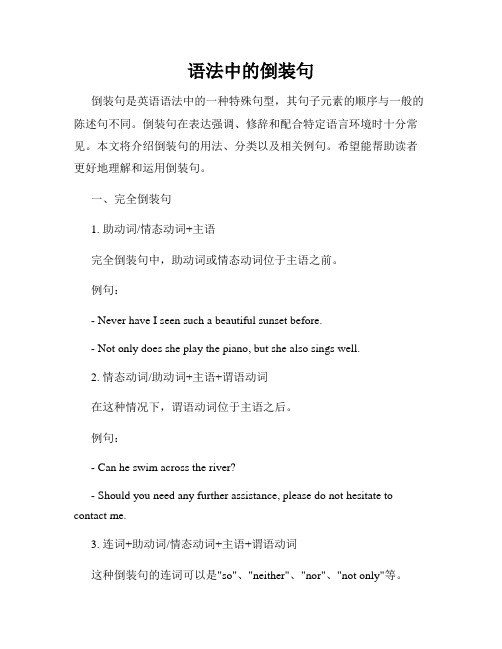
语法中的倒装句倒装句是英语语法中的一种特殊句型,其句子元素的顺序与一般的陈述句不同。
倒装句在表达强调、修辞和配合特定语言环境时十分常见。
本文将介绍倒装句的用法、分类以及相关例句。
希望能帮助读者更好地理解和运用倒装句。
一、完全倒装句1. 助动词/情态动词+主语完全倒装句中,助动词或情态动词位于主语之前。
例句:- Never have I seen such a beautiful sunset before.- Not only does she play the piano, but she also sings well.2. 情态动词/助动词+主语+谓语动词在这种情况下,谓语动词位于主语之后。
例句:- Can he swim across the river?- Should you need any further assistance, please do not hesitate to contact me.3. 连词+助动词/情态动词+主语+谓语动词这种倒装句的连词可以是"so"、"neither"、"nor"、"not only"等。
例句:- So popular is the movie that tickets are sold out.- Neither did he finish his homework, nor did he study for the test.二、部分倒装句1. 以介词短语、副词或介词短语开头当句子以介词短语、副词或介词短语开头时,常采用部分倒装结构。
例句:- In front of the house stood a tall tree.- Down the street ran a group of children.2. 在某些条件句中在某些条件句的主句中,为了强调条件,也会采用部分倒装结构。
倒装句的语法讲解+习题
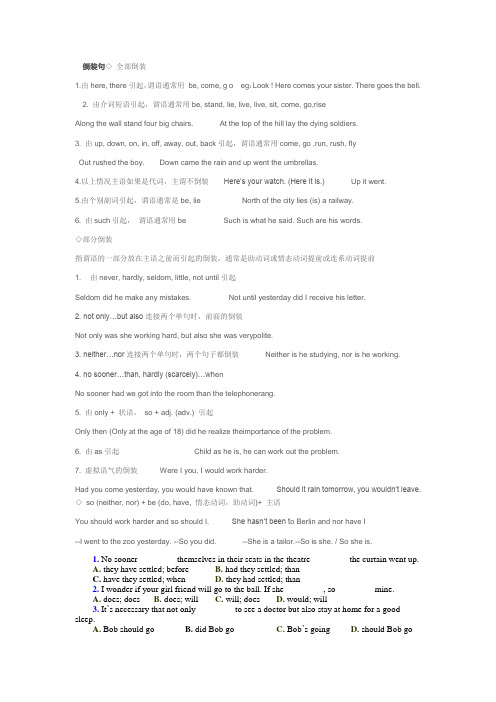
倒装句◇全部倒装1.由here, there引起,谓语通常用be, come, g o eg:Look ! Here comes your sister. There goes the bell.2. 由介词短语引起,谓语通常用be, stand, lie, live, live, sit, come, go,riseAlong the wall stand four big chairs. At the top of the hill lay the dying soldiers.3. 由up, down, on, in, off, away, out, back引起,谓语通常用come, go ,run, rush, flyOut rushed the boy. Down came the rain and up went the umbrellas.4.以上情况主语如果是代词,主谓不倒装Here’s your watch. (Here it is.)Up it went.5.由个别副词引起,谓语通常是be, lie North of the city lies (is) a railway.6. 由such引起,谓语通常用be Such is what he said. Such are his words.◇部分倒装指谓语的一部分放在主语之前而引起的倒装,通常是助动词或情态动词提前或连系动词提前1. 由never, hardly, seldom, little, not until引起Seldom did he make any mistakes. Not until yesterday did I receive his letter.2. not only…but also连接两个单句时,前面的倒装Not only was she working hard, but also she was verypolite.3. neither…nor连接两个单句时,两个句子都倒装Neither is he studying, nor is he working.4. no sooner…than, hardly (scarcely)…wh enNo sooner had we got into the room than the telephonerang.5. 由only + 状语,so + adj. (adv.) 引起Only then (Only at the age of 18) did he realize theimportance of the problem.6. 由as引起Child as he is, he can work out the problem.7. 虚拟语气的倒装Were I you, I would work harder.Had you come yesterday, you would have known that. Should it rain tomorrow, you wouldn’t leave.◇so (neither, nor) + be (do, have, 情态动词,助动词)+ 主语You should work harder and so should I. She hasn’t been t o Berlin and nor have I--I went to the zoo yesterday. --So you did. --She is a tailor.--So is she. / So she is.1. No sooner ________ themselves in their seats in the theatre ________ the curtain went up.A. they have settled; beforeB. had they settled; thanC. have they settled; whenD. they had settled; than2. I wonder if your girl friend will go to the ball. If she ________ , so ________ mine.A. does; doesB. does; willC. will; doesD. would; will3. It’s necessary that not only ________ to see a doctor but also stay at home for a good sleep.A. Bob should goB. did Bob goC. Bob’s goingD. should Bob go4. In ________ , but out ________ again.A. came the teacher; he wentB. came the teacher; went heC. did the teacher come; he wentD. the teacher came; went he5. It’s beyond description. Nowhere else in the world ________ such a quiet, beautiful place.A. can there beB. you can findC. there can beD. can find you6. Not until Dec. 2003 ________ caught by the US soldiers, and it was a great victory for the USA.A. was Saddam HusseinB. Saddam Hussein wasC. had Saddam Hussein beenD. Saddam Hussein had been7. Only after ________ his homework ________ to watch TV.A. he has finished; is he allowedB. has he finished; is he allowedC. he has finished; he is allowedD. has he finished; he is allowed8. Form then on we never saw her again, nor ________ from her.A. heard weB. had we heardC. we have heardD. did we hear9.“Never ____ to hurt your feeling while I was expressing myself in the discussion”explained Jim.A. I expectedB. expected IC. had I expectedD. did I expect10. ________ our bus; we’ll have to wait for the next.A. Does there goB. It goesC. There goesD. Does it go11.-It was careless of you to have left your new bike outside all night. -My god!________ .A. So did IB. So I didC. So was ID. So were you12. What a naughty boy he was! ________ .A. Down jumped he from the deskB. From the desk jumped he downC. He down jumped from the deskD. Down he jumped from the desk13. On the opposite wall ________ one map ________ dozens of pictures.A. hang; includingB. are hung; together withC. is hanged; withD. is hanging; as well as14. You can never use my computer. At no time ________ that machine.A. you should touchB. should you touchC. touch should youD. you touch15. Not until all the fish died in the river ________ how serious the pollution was.A. did the villagers realizeB. the villagers realizedC. the villagers did realizeD. didn’t the villagers realize【答案解析】1. B. 因为以否定词或半否定词开头的句子,要用部分倒装,排除A和D。
(完整版)高中英语语法倒装句讲解及练习(附答案)
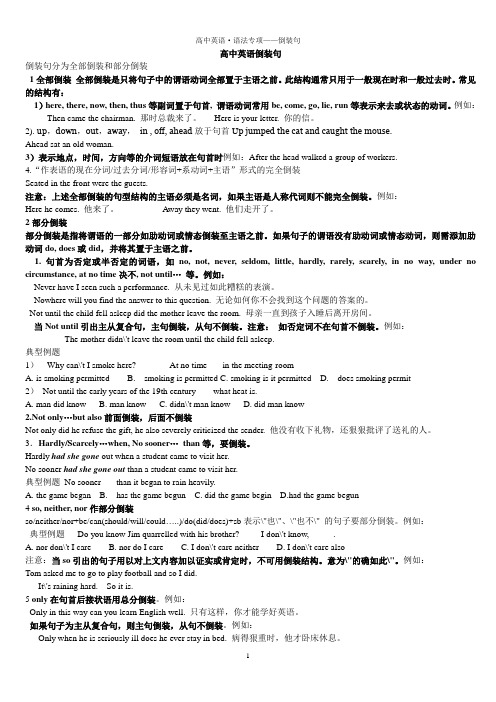
高中英语倒装句倒装句分为全部倒装和部分倒装1全部倒装全部倒装是只将句子中的谓语动词全部置于主语之前。
此结构通常只用于一般现在时和一般过去时。
常见的结构有:1)here, there, now, then, thus等副词置于句首, 谓语动词常用be, come, go, lie, run等表示来去或状态的动词。
例如:Then came the chairman. 那时总裁来了。
Here is your letter. 你的信。
2). up,down,out,away,in , off, ahead放于句首Up jumped the cat and caught the mouse.Ahead sat an old woman.3)表示地点,时间,方向等的介词短语放在句首时例如:After the head walked a group of workers.4.“作表语的现在分词/过去分词/形容词+系动词+主语”形式的完全倒装Seated in the front were the guests.注意:上述全部倒装的句型结构的主语必须是名词,如果主语是人称代词则不能完全倒装。
例如:Here he comes. 他来了。
Away they went. 他们走开了。
2部分倒装部分倒装是指将谓语的一部分如助动词或情态倒装至主语之前。
如果句子的谓语没有助动词或情态动词,则需添加助动词do, does或did,并将其置于主语之前。
1. 句首为否定或半否定的词语,如no, not, never, seldom, little, hardly, rarely, scarely, in no way, under no circumstance, at no time决不, not until…等。
例如:Never have I seen such a performance. 从未见过如此糟糕的表演。
Nowhere will you find the answer to this question. 无论如何你不会找到这个问题的答案的。
- 1、下载文档前请自行甄别文档内容的完整性,平台不提供额外的编辑、内容补充、找答案等附加服务。
- 2、"仅部分预览"的文档,不可在线预览部分如存在完整性等问题,可反馈申请退款(可完整预览的文档不适用该条件!)。
- 3、如文档侵犯您的权益,请联系客服反馈,我们会尽快为您处理(人工客服工作时间:9:00-18:30)。
倒装句用法小结:一般来说,倒装分为全部倒装和部分倒装,有的倒装是因为语法需要而出现的,有的则是因为结构平衡或强调而出现的。
一、部分倒装:1.用于疑问句中。
如:How did you do that? Did you see the film yesterday?2.用于省略if的虚拟条件状语从句中。
如果我们将连词if省略,应把were,had,should提到主语前面。
如:If you had come yesterday, you would have seen him.=Had you come yesterday, you would...If I were to / should take piano lessons, I would have less time to play.=Should / Were I to take …3.用于as引导的让步状语从句中。
As引导的让步状语从句引起的倒装有以下几种形式:副词置于句首。
如:Much as I like it (=Although I like it very much), I will not buy it.动词置于句首。
如:Wait as you may (= Although you may wait), he will not see you.形容词或名词置于句首。
如:Proud as the nobles are (=Although the nobles are proud), they are afraid to see me.Child as he is (=Although he is a child), he can tell right from wrong.注意:如果名词前有形容词修饰时,as引导的倒装句中要保留不定冠词。
如:A bad-tempered man as he is (=Although he is a bad-tempered man), he loves me deeply.4.具有否定意义的副词或连词(not, hardly, no sooner, not until, seldom, not once, at no time,never, little等)置于句首时,句子(主句)用部分倒装。
Little do we know about him.Seldom does he come back on Sundays.Not until he came back did I know about it.Never will I forget about this experience.Hardly had we entered the classroom when the bell rang.No sooner did he come back than he telephoned Tom.5.only修饰状语(从句)位于句首时,句子的主句部分要用部分倒装。
如:Only then did I realize the important of English.Only when a child grows up does he understand his parents’ intentions.Only in this way can you solve the problem.Only if you ask different questions, can you acquire the information you need.但如果only修饰的是句子的其它成分,则无需倒装。
如:Only socialism can save China. (only修饰的是句子的主语,故仍用正常语序)连接两个并列分句时,第一个分句应使用部分倒装。
如:6.not only…but also…Not only does he do well in his lessons, but also he often helps others with their lessons.7.So/such…that结构中的倒装:强调so 所修饰的形容词或副词,常将so连同它所修饰的形容词或副词一起提到句首。
这时,主句要用倒装结构。
如:He runs so fast that he is far ahead of others.= So fast does he run that he is far ahead of others.He is so clever that he can work out all the difficult problems by himself.=So clever is he that he can work out all the difficult problems by himself.二、全部倒装:1.以here, there,now, then开头的句子,谓语动词要放在句子的主语之前,这种句子中的谓语动词通常是不及物动词。
如:Here comes the train! / There goes the bell!注意:如果句子的主语是人称代词,则不用倒装结构。
如:Here it comes! / There it does!2.有些动词短语以副词out, in, up, down, away等结尾,构成不及物动词短语。
这时,为了使句子更形象,常将这些副词提前到句首。
这时,句中的谓语动词要放在句子主语的前面,构成全部倒装。
Away went the boy. / In came Mary.(注意,如果是人称代词,也不用倒装结构。
)如:In she came. / Away he went.3.为了强调表示地点的介词短语,常将这个介词短语放在句首,构成全部倒装。
注意,这时句子的谓语动词通常是不及物动词。
如:stand , lie, sit...In the front of the lecture hall sat the speaker.Behind the desk stands the professor, who has developed a new medicine.Between the two hills lies a lake.4.表语置于句首,且主语较长或结构较复杂的句子要用全部倒装。
如:Gone are the days when we had nothing to eat.5.so/ neither/ nor 表示前面所说的情况也适合于后者,其倒装结构为“so/ neither/ nor+助动词/系动词/情态动词”,这里的主语同前一个句子的主语指的是同一人或物。
如:She has finished her homework, so has her brother.She hasn’t gone there, neither/ nor has he.但如果so表示强调前面所说的情况的真实性时,其结构是“so+主语+助动词/系动词/情态动词”,这里的主语与前一个句子主语指的是同一人或物。
如:She knows little English, so she does. (她英语懂得不多,的确如此。
)注意: 区分So do I . (我也是) So I do. (的确是) I do so. (这样做)6. there be 句式的各种形式:there be (will be;used to be) There (exist; live ; seem)There exists a serious problem. There exist/existed serious problems.Once upon a time, there lived an old man.There seems something wrong with my radio.There is a teacher and some students in the classroom .高二倒装句练习题-英语1. Not until I began to work ____ how much time I had wasted.A. didn't I realizeB. did I realizeC. I didn't realizeD. I realized2. Only by practising a few hours every day ____ be able to master the language.A. you canB. can youC. you willD. will you3. If you don't go,neither ____.A. shall IB. do IC. I doD. I shall4. No sooner ____ to the station ____ the train left.A. had I got,whenB. I had got,thanC. had I got,thanD. did I get,when5. ---- Your father is very strict with you.---- ____. He never lets off a single mistake ofoursA. So he isB. So is heC. He is soD. So does he6. ____ today,he would get there by Sunday.A. Would he leaveB. Was he leavingC. Were he to leaveD. If he leave7. Never in my life ____ such a thing. A. I have heard or have seenB. have I heard or seenC. I have heard or seenD. did I hear or see8. ---- Here ____!Where is Xiao Liu?---- There ____.A. comes the bus,is heB. comes the bus,he isC. the bus comes,is heD. the bus comes,he is9. ____ ,I will not buy it.A. Much as do I like itB. As much I like itC. Much as I like itD. As I like it much10. ---- I like football. I don't like volleyball.---- ____.A. So do IB. Neither do IC. So it is with meD. So is it with me11._____ the expense,I _____ to Italy.A. If it were not,goB. Were it not for,would goC. Weren't it for,will goD. If it hadn t been,would have gone12. So _____ in the darkness that he didn' t dare to move an inch.A. he was frightenedB. was he frightenedC. frightened he wasD. frightened was he13.-In modem times,girls like beautiful clothes.-Yes,_____ and boys. After all,our life has greatly improved.A. so do they;so do youB. so they do;so you doC. so do they;so you doD. so they do;so do you14.-You have an English class every day except Sunday.--- _____.A. So we haveB. So we doC. So have weD. So do we15.1 wonder if your wife will go to the ball. If your wife _____,so _____ mine.A. does;willB.will;doesC.will;wouldD.does;do16. Only after I read the text over again _____ its main idea.A. that I knewB.did I knewC. 1 could knowD. I did know17.-You seem to have learned all the English words by heart.A.Sol doB.SodolC. So I haveD. So have 118. -I seldom watch TV,but listen to the radio a lot.A. So do IB. Neither do IC. I m the sameD. So it is with me19. So excited _____ that he couldn't say a word.A. he seemedB. did he seemC. was he seemingD. he did look20. Jimmy was so nervous not a single word _____ down in the dictation.A. he wroteB. he was writtenC. did he writeD. was he written21. Little ______ when 1 took the trip where it would lead me.A. have I knownB. had I knownC. do 1 knowD. did I know22. -Have you ever seen anything like that before?- ____.A. No,I never have seen anything like that beforeB. No,never I have seen anything like that beforeC. No,never have 1 seen anything like that beforeD. No,I have seen anything like that before never23. _____ , 1 would accept the invitation and go to the party.A. Were I youB. Was I youC. Had I been youD. Would 1 be you24. You should work less _____.A. and neither should IB. and so should IC. and nor should ID. and so I should25. _____ and caught the mouse.A. Up the cat jumpedB. The cat up jumpedC. Up jumped the catD. Jumped up the cat26. Not only _____ a promise,but also he kept it.A. did he makeB. he madeC. does he makeD. has he made27. His uncle is a worker and has been working in the factory for more than ten years._____.A. So is his auntB. So has his auntC. So his aunt doesD. So it is with his aunt28. Not once _____ their plan.A. did they changeB. they changedC. changed theyD. they did change29.-Do you know Jim quarreled with his brother?-I don't know,and ______ .A. nor don't I careB. nor do I careC. I don't care neitherD. I don't care also30. Not until he arrived home _____ he find that this wallet had been stolen.A. didB. wouldC. whenD. that31. -This is one of the oldest trees in the world.- _____ such a big tree.A. Never I have seenB. I haven't never seenC. Never have I seenD. I have seen never32. Nowhere else in the world _____ cheaper tailoring(裁缝业,成衣业)than in Hong Kong.A. a tourist can findB. can a tourist findC. a tourist will findD. a tourist has found33. _____ succeed in doing anything.A. Only by working hard we canB. By only working hard we canC. Only we can by working hardD. Only by working hard can we34. _____ that we all went out,lying in the sun.A. So fine was the weatherB. So was the fine weatherC. The weather was so fine wasD. So the weather was tine35. ____ a nice man ____ that we all believe him.A. So;did he seemB. So;he seemedC. Such;he seemedD. Such;did he seem36. -You seem to be an actor.-_____. I have played many parts in a lot of films.A. So do IB. So am IC. So I doD. So I am37. Not only ____ working hard,but also ____ very polite.A. the boy is;he isB. is the boy;he isC. the boy is;is heD. is the boy;is he38. _____ ,he never seems able to do the work beautifully.A. Try as he doesB. As he triesC. Try as does heD. As try he does39.-I cannot see the picture well from here. - _____.A. Neither can t IB. Neither I canC. I can't neitherD. Neither can I40.- You ought to have given them some advice- _____,but who cared what I asked?A. So ought youB. So 1 oughtC. So it wasD. So I did41. So carelessly _____ that he almost killed himself.A. he drivesB. does he driveC. did he driveD. he drove42. Little _____ about his own health though he was very ill.A. he caredB. did he careC. he caresD. does he care43. Well ____ know him and well ____ know me.A. I did;he didB. did I;he didC. did I;did heD. I did;did he44. No sooner ____ they rushed out into the street.A. did they hear the news thanB. did they hear the news whenC. had they heard the news thanD. had they heard the news when45. Little wonder _____ up their hands in dismay.A. have some thrownB. some have thrownC. thrown some haveD. have thrown some46. _____ ,he would have passed the exam.A. If he were to studyB. If he studied hardC. Had he studied hardD. Should he study hard47. We were lucky enough,for no sooner _____ home _____ it rained.A. we returned;andB. we had returned;whenC.did we return;whenD. had we returned;than48. So little _____ agree on the plan that they could not settle their difference.A. did theyB. do theyC. they didD. they did not49. _____ he realized it was too late to return home.A. No sooner it grew dark thanB. Hardly did it grow dark whenC. It was not until dark thatD. It was until dark that参考答案1~5 BDACA6~10 CBBCC11~15 BDDBA16~20 BADBC21~25 DCABC26~30 ADABA31~35 CBDAD36~40 DBADD41~45 CBCCB46~49 CDAC。
